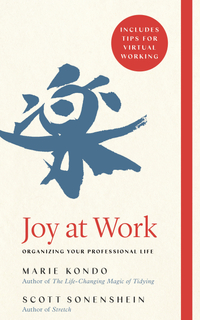In her recently republished book, Joy at Work, Ms. Kondo shares reveals the home office ideas that hold the secret to a more joyful workspace – and her clutter cutting technique works for desks and workspaces of all sizes. In an exclusive excerpt of the latest edition below, the celebrated organizer reveals her tips – and what you need to know to keep your home office setup running seamlessly.
Marie Kondo’s 3 tips for cutting paperwork clutter
‘Even if you tidy up, papers are bound to pile up again quickly, making rebound inevitable. But there’s no need to worry. As long as you follow the three rules of storage I introduce below, you’ll never return to paper clutter.’
Rule 1: Categorize every paper down to the last sheet
‘Start by sorting your papers into clear categories, such as presentations, project proposals, reports, and invoices. Or you could sort them by dates, projects, or the names of individual clients, patients, or students. One of my clients, for example, designated files for Design Ideas, Management Ideas, English Study, and Documents to Keep and Remember. Use whatever system works best for you. ‘The most important point is never to store even a single sheet of paper “just because.” Now is the time to categorize your papers in a way that makes your work easier. Make sure every paper is sorted into a category.’
Rule 2: Store your papers upright
‘Do you know people who are always asking, “Where did that file go?” Often it’s because they are piling their files in stacks on their desk. There are two disadvantages to stacking documents. First, it’s difficult to determine how much you have, so you don’t notice how much you are accumulating over time and end up with a messy desk. Second, you forget about the files at the bottom of the pile and waste time looking for them. ‘For optimal efficiency, it’s crucial to store your papers in a hanging- file system. Put each category of papers in a separate folder and store them in a filing cabinet or upright in a filing box placed on a shelf. Storing them this way makes it easy for you to see how many papers you have. It also looks neat and tidy.’
Rule 3: Make a pending box
‘Make a pending box, in which to keep only those papers that you need to deal with on that day. Again, I recommend using an upright filing box so that you can clearly see how many papers need processing. If you prefer, you can use a tray-type filing box and store them flat, but be sure not to forget the existence of the papers on the bottom. When you’ve processed pending papers, discard those that don’t need to be kept. ‘Just as for tidying anything else, tidying up your papers makes them incredibly easy to manage because you know exactly how many of each type you have and where they are. Once you have sorted your papers and decided where each category belongs, look at your workspace and determine the maximum amount of space you have available for storing them. When you exceed this storage capacity, papers will begin to overflow. That’s a signal that you need to reexamine what’s there. Check for papers that no longer need to be saved, and let them go. By checking regularly like this, you can keep your papers tidy at all times.’ Whether you are looking for large or small home office ideas, Marie’s paper tips will ensure your space stays tidy for good. Excerpted from JOY AT WORK © 2021 by KonMari Media Inc. and Scott Sonenshein. Used with permission of Macmillan Publishers. All rights reserved.
